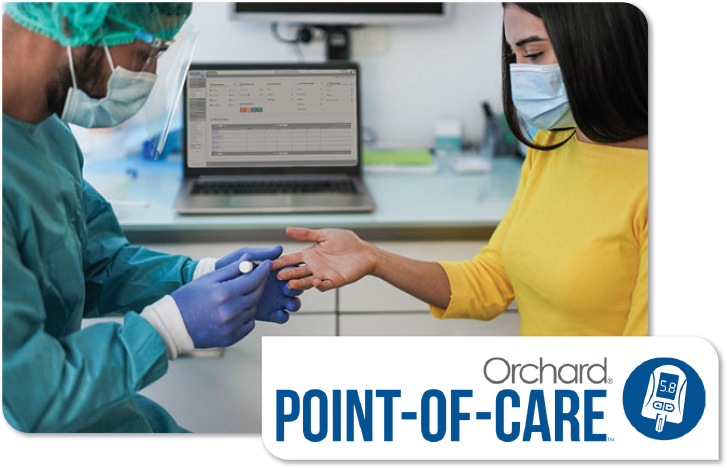Summary
At Orchard Software, we pride ourselves on researching and developing software tools that laboratory professionals can use to make their jobs easier and more productive, helping them maximize their value. We are also in tune with current healthcare and industry trends. These two factors have led to the development of our point-of-care testing (POCT) integration and management software, Orchard® Point-of-Care™. From a reimbursement perspective, Orchard Point-of-Care’s capability to automate POCT billing and help close care gaps using CPT II Codes makes the solution applicable for both fee-for-service (FFS) reimbursements and for value-based or performance-based contracts.
Orchard Point-of-Care Overview
 Orchard Point-of-Care is designed for remote oversight of POCT, supporting centralized governance of a comprehensive POCT program across patient testing locations. Orchard Point-of-Care solves many of the problems associated with POCT management by enabling remote oversight to track patient testing, devices, operator certifications, and QC. The solution also integrates POCT into the EHR to allow immediate access to results and automate the billing process. Orchard Point-of-Care provides the optimal means for electronic connectivity to effectively manage POCT. The solution can help improve patient care and enhance the value of your POCT by ensuring real-time electronic capture of POCT results, allowing prompt access to results for quick diagnosis and patient treatment. Orchard Point-of-Care offers superior connectivity that enables rapid implementation of new interfaces and timely result delivery to speed patient diagnosis and treatment. It includes vendor-agnostic device connectivity with the ability to rapidly add new device interfaces without disruption.
Orchard Point-of-Care is designed for remote oversight of POCT, supporting centralized governance of a comprehensive POCT program across patient testing locations. Orchard Point-of-Care solves many of the problems associated with POCT management by enabling remote oversight to track patient testing, devices, operator certifications, and QC. The solution also integrates POCT into the EHR to allow immediate access to results and automate the billing process. Orchard Point-of-Care provides the optimal means for electronic connectivity to effectively manage POCT. The solution can help improve patient care and enhance the value of your POCT by ensuring real-time electronic capture of POCT results, allowing prompt access to results for quick diagnosis and patient treatment. Orchard Point-of-Care offers superior connectivity that enables rapid implementation of new interfaces and timely result delivery to speed patient diagnosis and treatment. It includes vendor-agnostic device connectivity with the ability to rapidly add new device interfaces without disruption.
Orchard Point-of-Care includes a multitude of tools that support regulatory compliance:
- Advanced rules engine that supports POCT workflow and sample tracking
- Centralized management of operator certifications
- Graph linearity and calibration verification data
- Extensive QC capabilities and reagent tracking
- Extensive audit trail capabilities
- User-friendly data mining tools
Automated Billing in FFS
 Often, many POC tests are not billed because the billing collection steps are too cumbersome. In a recent survey, we found that up to 49% of respondents do not bill for POCT glucose. AGlucose reimbursement rates vary between $4 and $5 each, so healthcare organizations (HCO) that do not bill for glucose may be missing a significant opportunity.
Often, many POC tests are not billed because the billing collection steps are too cumbersome. In a recent survey, we found that up to 49% of respondents do not bill for POCT glucose. AGlucose reimbursement rates vary between $4 and $5 each, so healthcare organizations (HCO) that do not bill for glucose may be missing a significant opportunity.
Orchard Point-of-Care receives POCT orders from the EHR, sends the completed results back to the EHR for rapid access, and simultaneously sends a message to the billing system when testing is completed. With this process, billing is automated, eliminating the need for manual intervention. Billing events can be sent to the EHR when the order is complete, when the order choice is saved, or when results are complete. In a FFS scenario, Orchard Point-of-Care automates POCT billing using applicable Current Procedural Terminology (CPT) Codes and modifiers, ensuring that each POCT is appropriately billed.
A Contract-enhancing Tool for Value-based Care
For value-based or performance-based contracts, the use of CPT codes to demonstrate care gap closure is one way in which quality is being documented for payers. For this quality initiative model, Orchard Point-of-Care can support the addition of CPT II codes to close care gaps, thereby improving performance in value-based contracts. CPT II codes are a newer version of CPT codes that are used to assess Healthcare Effectiveness Data and Information Set (HEDIS) and Star rating scores. HEDIS is a set of standardized performance measures developed by the National Committee for Quality Assurance (NCQA) that is used to measure and compare quality across health insurance plans. The Centers for Medicare & Medicaid Services (CMS) Five-Star Quality Rating System is used to measure the quality of care for Medicare Advantage (MA) and Prescription Drug Plan (Part D) beneficiaries. Both HEDIS and Star ratings affect HCO reimbursements and bonuses. Additionally, per-member/per month (PMPM) reimbursements can be improved by inclusion of follow-up CPT II Codes.
CPT II codes are used to help “grade” performance by providing additional information to the insurance provider that demonstrates the level of quality. For example, in tracking Hgb A1c levels for diabetic patients, the CPT II codes correspond to the Hgb A1c result, showing the insurance company where the patient stands regarding their diabetes. Orchard Point-of Care can automate the attachment of CPT II Codes to the claims so that the data can be sent to the payers; this helps to automate care gap closure on several key measures. As a result, both the health plan and the providers participating in value-based contracts benefit from this automated process. Most importantly, so do the patients, as the quality of their care is more accurately reflected in their records.
Orchard Point-of-Care for Comprehensive POCT Oversight
In today’s HCOs, the complexity of POCT calls for a comprehensive management and integration software tool that integrates with the EHR, supports billing, and allows remote oversight of POCT activities. In particular, as healthcare reimbursements fall in both FFS and performance-based models Orchard Point-of Care can act as a tool to improve POCT reimbursements by automating capture of billing information. For more information about Orchard Point-of-Care, visit www.orchardsoft.com or call (800) 856-1948.
